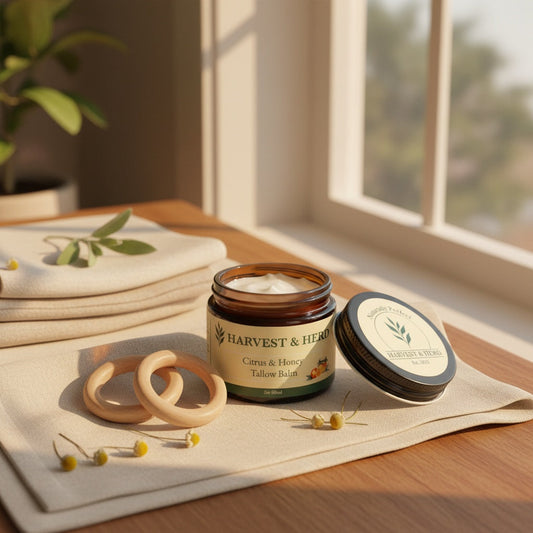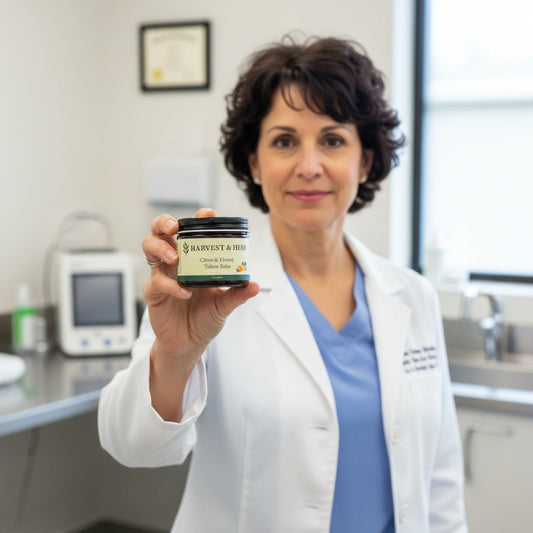
Why Dermatologists Are Rethinking Tallow for Eczema
Share
Here's something most skincare companies won't tell you: the most sophisticated solution for eczema might be the simplest one. After years of watching patients cycle through expensive creams with minimal results, dermatologists are seeing remarkable transformations with an ingredient your grandmother probably kept in her kitchen.
Let's be clear about what we're discussing. This isn't about slathering just any rendered fat on your skin. This is about understanding why grass-fed tallow specifically formulated into a proper balm addresses eczema at a molecular level that synthetic alternatives often miss.
The Science Your Dermatologist Is Just Starting to Discuss
Think of your skin barrier like the mortar between bricks in a wall. In healthy skin, this mortar contains specific fatty acids: palmitic acid, oleic acid, and stearic acid, in precise ratios. When you have eczema, that mortar is compromised. Gaps form. Moisture escapes. Irritants invade. The result? That maddening cycle of inflammation, itching, and flaking you know too well.
Here's where it gets interesting. Recent research published in Cureus revealed something remarkable: grass-fed tallow contains these exact fatty acids in proportions that mirror healthy human skin1. We're talking about 24-28% palmitic acid—the same concentration your skin uses to maintain its barrier function.
Most moisturizers try to create an artificial seal over damaged skin. Tallow does something different. It provides the actual building materials your skin needs to repair itself. It's the difference between putting a tarp over a damaged roof versus replacing the missing shingles with identical materials.
What the Research Actually Shows
The scientific community is catching up to what traditional knowledge has long suggested. A 2024 comprehensive review examined tallow's biocompatibility with skin, concluding it shows "low irritancy and superior lipid replenishment compared with mineral oil-based emollients"1. That's clinical speak for: it works better than petroleum-based products without causing reactions.
But the real story emerges when you look at the mechanism. Research in Nutrients demonstrates that the specific fatty acid profile in tallow doesn't just moisturize, it actively modulates the inflammatory cascade that drives eczema symptoms2. The fat-soluble vitamins A, D, K, and E naturally present in grass-fed tallow act as co-factors in skin repair processes that synthetic ingredients can't replicate.
Why Quality and Formulation Matter
Here's where we need to be direct: not all tallow products are created equal. Most tallow balms have texture issues, scent problems, or both. They're whipped full of air to mask poor formulation, or they smell like the farm the tallow came from.
We formulated our Citrus & Honey Tallow Balm differently. No whipping because air bubbles are a shortcut, and shortcuts don't create the best product. Instead, we spent a year perfecting a formulation that's naturally smooth and creamy. The addition of honey and royal jelly provides additional antimicrobial and healing properties, particularly relevant since Staphylococcus aureus colonization often aggravates eczema3.
The citrus oils? Carefully selected and balanced at concentrations that provide a pleasant experience without triggering sensitivities. Frankincense and sandalwood add anti-inflammatory benefits backed by research, not just aromatherapy claims.
A Practical Protocol for Eczema Management
Let's talk application. This isn't about slathering and hoping for the best. There's a method that maximizes effectiveness:
The Patch Test (Non-Negotiable for Sensitive Skin)
- Apply a small amount to your inner wrist or behind your ear
- Wait 24-48 hours
- No reaction? You're ready to proceed
The Application Method
- Timing: Within 3 minutes after bathing (the "soak and seal" approach clinicians recommend)
- Amount: Less than you think—tallow is concentrated. Start with a pea-sized amount
- Technique: Warm between fingertips, then press gently into damp skin
- Frequency: Twice daily during flares, once daily for maintenance
Working with Your Current Treatment
Tallow doesn't replace medical treatment for severe eczema. Think of it as foundational care. Use it on all affected areas, reserving prescription treatments for active flares. Studies show that proper emollient use can reduce steroid dependency by up to 50% when used correctly.
Real Results, Realistic Expectations
One of our customers, Sarah, sent us a photo from her beach vacation six months after starting with our balm. "No hiding under long sleeves," she wrote. "No constant worry about flare-ups. Just normal skin doing normal skin things."
That's what proper barrier repair looks like. Not overnight miracles, but steady, sustainable improvement. Most users report noticeable changes in skin comfort within the first week, with significant barrier improvement visible after 4-6 weeks of consistent use.
The Bigger Picture
The resurgence of tallow in dermatological circles represents something larger: a recognition that working with the skin's natural processes often yields better results than trying to override them with synthetic chemistry.
Every ingredient in quality tallow balm serves a purpose rooted in skin biology. The saturated fats integrate into your skin's lipid matrix. The vitamins support cellular repair. The natural antimicrobials help maintain healthy skin flora. It's comprehensive care that respects your skin's complexity.
For those seeking alternatives to the endless cycle of temporary relief followed by disappointing flare-ups, tallow offers a different path. One based on providing what your skin actually needs to heal itself, rather than just managing symptoms.
Making an Informed Decision
Is tallow right for your eczema? Consider these factors:
- Severity: Mild to moderate eczema responds best. Severe cases need medical oversight
- Skin type: Dry, sensitive skin typically sees the most benefit
- Previous reactions: If you've reacted to multiple products, tallow's simple composition reduces risk
The science is clear: tallow's unique composition makes it exceptionally suited for eczema-prone skin. The question isn't whether it works, the research confirms that. The question is whether you're ready to try something that actually addresses the root cause of your skin barrier dysfunction.
Sometimes the most advanced skincare science leads us back to the simplest solutions. In the case of eczema, that solution has been hiding in plain sight, waiting for us to understand why it works so well.
References
1. Russell MF, et al. Tallow, rendered animal fat, and its biocompatibility with skin: A scoping review. Cureus. 2024;16(5):e60981. doi:10.7759/cureus.60981
2. Olejnik A, et al. Fatty acids profile and the relevance of membranes as the target of nutrition-based strategies in atopic dermatitis: A narrative review. Nutrients. 2023;15(17):3857. doi:10.3390/nu15173857
3. Bronsnick T, Murzaku EC, Rao BK. Diet in dermatology: Part I. Atopic dermatitis, acne, and nonmelanoma skin cancer. J Am Acad Dermatol. 2014;71(6):1039.e1-1039.e12. doi:10.1016/j.jaad.2014.06.015



